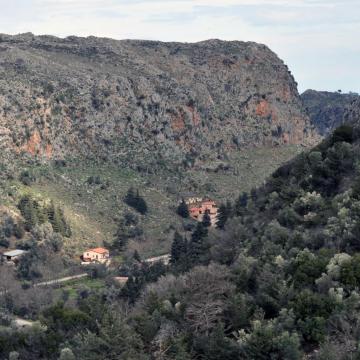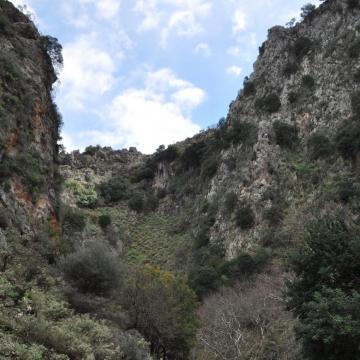GR4340007 - FARANGI THERISSOU
Map
Quality
The quality and importance of Therissos gorge is comprised of the following elements: 1) It is of great aesthetic value. 2) It is easy to approach, due to its location near the town of Chania and the existence of the road, running along it. 3) There is a variety of sufficiently conserved habitats within a small area. 4) Its flora is rich in common and endemic species; the latter are of great interest and most of them are rare or threatened and protected at international (Bern Convention) or national (Presidential Decree 67/81) level. The local endemics Ferulago thyrsiflora and Petrorhagia dianthoides and the non-endemic Ranunculus creticus are included in the IUCN Red Data List (1993) in the category of threatened plants characterized as "rare" and they are protected by the Greek Law (Presidential Decree 67/81). Other important species are: Lactuca acanthifolia (= Scariola acanthifolia) is found in Ydra, Cyclades, East Aegean Islands andonly in SW Turkey out of Greece. The species Onosma graeca is found ionly in NW Anatolia, out of Greece. Brassica cretica ssp. cretica is a chasmophyte occurring only in C. and S. Lebanon out of Greece. 5) The rarity of the snake Elaphe situla (which islisted in the Annex II of the Council Ditective 92/43/EEC) which lives in the site together with the fact that Crete is the southernmost limit of this species distribution, make its preservation very important for the fauna of the island. Other important species with motivation D: Podarcis erchardii: There is a dense population of the species in the site, in contrast with the rest of Crete, which is the southernmost limit of its distribution. So, the conservation of this population is of great importance for the preservation of the reptile fauna of the island as a whole.
Other characteristics
Therissos gorge is located about 6 km south of the town of Chania, between the villages Perivolia and Therissos. Along the canyon there is a road joining Chania with the mountain Lefka Ori. Its width varies from 15 to 250 m and its length is about 9 km. A small valley is formed at the broadest area, at the entrance of the canyon which is cultivated with woody plants (orchards and vineyards). The rest of the site is characterized by cliffs, chasms, and screes, with a variety of endemic plants. Along the stream there are groups of Platanus orientalis and Nerium oleander. Around the gorge there are phrygana in a good condition and caves not open to the public. There is also a small cypress forest near the village of Therissos.NOTES9320 is used to describe Oleo-Ceratonia matorral (not forest).
Documentation
1) 3.3.c., 3.3., 4.1., 4.2., 4.3.:
1) MEDSPA Database.
2) Economidou E. 1988. Entopismos kai meleti ton ygroviotopon kai allon simantikon gia tin ornithopanida viotopon tis Kritis (Location and study of the wetlands and other important for the birds species biotopes in Crete). Athens University.
3) Turland N.J., Chilton L. & Press J.R. 1993. Flora of the Cretan area. London, HMSO.
4) Sowig P. 1985. Beitrage zur Kenntnis der Verbeitung und Okologie der Amphibian und Reptilien Kretas. Salamandra 21(4):252-267
5) Archives of the Hellenic Zoological Society.
6) Valakos E. Personal communication.
7) Kypriotakis Z. Personal communication.
8) Paragkamian K. Personal communication. 9)
Vardinoyannis K. 1994. Viogeografia ton cherseon malakion sto notio nisiotiko Agaiako toxo (Biogeography of land snails in the south Aegean arc). Phd Thesis. Athens University.
10) Georghiou K. 1995. Checklist of Endemic, Rare and Threatened Plants of Greece. Draft. University of Athens. (3.3, 3.4, 4.2)
Reference: Natura 2000 data form, database release 7 Feb 2014





